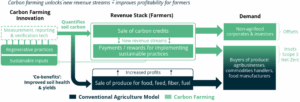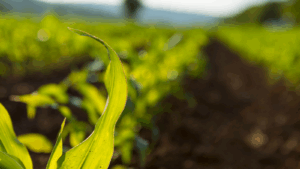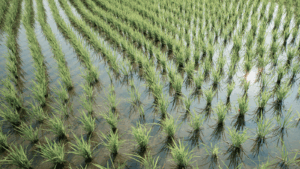Generating Carbon Offsets in Carbon Farming
Soil carbon and carbon farming deal with organic carbon that is present or stored in soil. It occurs when animals and plants that have died or are decaying, become integrated with the soil. It also includes living organisms, microbes that are present as well as inorganic material that forms the carbon content of soil.
It is important for the soil to have a certain amount of carbon in it and there are benefits to sequestering more carbon in agricultural soils. The organic carbon content of soil actually has many advantages for the growth of plants or crops because it encourages better soil structure, which in turn allows for better water retention, to enhance the plant’s ability to uptake nutrients from the soil.
Agricultural activity actually releases carbon from the soil, so activities like tilling, planting seeds, and grazing animals disrupt the soil and therefore, carbon is emitted in the process, contributing to greenhouse gas emissions. Carbon farming addresses ways to maintain or enhance soil carbon levels that are being lost through agricultural activity.
The Soil Carbon Market
Soil organic carbon is a critical factor for soil fertility and crop productivity. By enhancing soil structure, carbon improves water retention and nutrient cycling, which are essential for resilient farming systems, especially under climate stress. This dual role makes carbon farming both an environmental and agronomic priority. Soil organic carbon is vital for improving soil health, water retention, and nutrient uptake in crops.
If you’re sequestering carbon into the soil, there are opportunities where you can generate offsets, and gain the benefit of having optimal soil carbon levels. With all the discussion around carbon markets, there is a drive towards actually monetizing some of that carbon storage in the form of offsets or credits. On the one hand, there is the possibility of measuring and verifying common content and then selling that as offsets to companies that are looking to offset their own emissions.
But most of what we’re seeing now is setting — companies in the agrifood value chain who have Scope 3 emissions that they want to reduce, like net-zero commitments to stick to. They are looking upstream at their farmer partners and trying to think about ways that they can help them to sequester more carbon in the soil and maintain soil carbon levels, and perhaps enhance those through practices like regenerative agriculture, the use of soil amendments that actually add carbon back into the soil. They are trying to work together to come up with initiatives that enable that and reward their farmer partners for meeting some of those objectives.
Corporate Engagement Drives Market Development
Major agrifood corporations are developing carbon farming programs to engage and reward farmers, effectively creating demand-side pressure that can accelerate adoption of carbon-friendly practices. Some that are running regenerative ag initiatives that have a carbon component to them include:
- PepsiCo
- Arla
- Cargill
They each have programs where they are trying to incentivize their partner farms to sequester more carbon in their soil, adopt regenerative agriculture practices that do that, and have many other co-benefits.
Innovation of Interest
There are also innovators involved with soil amendments or just enhanced weathering, processes to add compounds into the soil and that also help with soil resiliency, as well as providing carbon sequestration benefits. These tools facilitate collaboration between farmers and corporates, improve market credibility, and help integrate carbon credits into larger supply chain sustainability strategies.
Lithos is a company based in California producing a rock-based soil amendment. Farmers could add this material to their fields to increase carbon levels, thereby sequestering carbon. These products work by adding stable forms of carbon to soils, potentially offering a scalable and direct method of sequestration.
There are also companies like Regrow, who are providing a software platform and tools to help farmers and corporates understand carbon levels in their soil and share that information throughout their supply chains.
Conventionally, much of this work has been done by taking physical samples from the soil. An agronomist or a farmer would walk into the field and take a sample of the soil, then send it to a lab to be analyzed. This tends to be very time consuming. It can take weeks for that sample to get to the lab and come back to the farmer, and it can be expensive. But to have a credible, high functioning market in agricultural soil carbon credits, things will need to be able to move a bit quicker because soil carbon levels are very dynamic.
Much of the innovation in advanced monitoring is about supplementing conventional soil sampling with other technologies that can give a real-time picture of soil carbon levels. These include satellite imagery or other forms of aerial imagery from drones or aircraft. It also includes on-site soil sensing.
Innovation and growing interest in carbon farming is a vital strategy for sustainable agriculture and climate action, with further developments expected in the near future.
Looking Ahead
Carbon farming is a rapidly evolving field with significant potential for climate mitigation and sustainable agriculture. As markets mature and measurement techniques improve, carbon farming could become a cornerstone of climate-smart agriculture, offering co-benefits that include improved soil health, enhanced biodiversity, and increased farm resilience against climate impacts.


